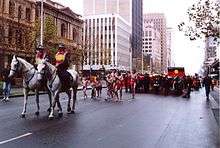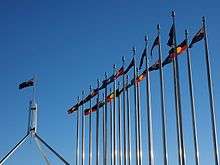Australian Aboriginal Flag


The Australian Aboriginal Flag is a flag that represents Aboriginal Australians. It is one of the official flags of Australia, and holds special legal and political status, but it is not the "Australian National Flag". It is often flown together with the national flag and with the Torres Strait Islander Flag, which is also an official flag of Australia.
The Australian Aboriginal Flag was designed in 1971 by Aboriginal artist Harold Thomas, who is descended from the Luritja people of Central Australia and holds intellectual property rights to the flag's design. The flag was originally designed for the land rights movement, and it became a symbol of the Aboriginal people of Australia.
The flag's width is 1.5 times its height. It is horizontally divided into a black region (above) and a red (Pantone 179) region (below). A yellow (Pantone 123) disc is superimposed over the centre of the flag.[1]
Status
The Government of Australia granted it Flag of Australia status, under the Flags Act 1953, by proclamation on 14 July 1995.[2]
Due to an "administrative oversight",[3] the 1995 proclamation was not lodged so that it would continue in force indefinitely; hence it automatically expired on 1 January 2008. It was therefore almost identically replaced, on 25 January 2008, with effect as from 1 January.[4]
In the 2008 proclamation, the flag "is recognised as the flag of the Aboriginal peoples of Australia and a flag of significance to the Australian nation generally" and appointed "to be the flag of the Aboriginal peoples of Australia and to be known as the Australian Aboriginal Flag". The design is reproduced in Schedule 1 and described in Schedule 2.
Symbolic meaning
The symbolic meaning of the flag colours (as stated by Harold Thomas) is:[5]
- Black – represents the Aboriginal people of Australia
- Yellow circle – represents the Sun, the giver of life and protector
- Red – represents the red earth, the red ochre used in ceremonies and Aboriginal peoples’ spiritual relation to the land
History

The flag was first flown on National Aborigines Day in Victoria Square in Adelaide on 12 July 1971.[5] It was also used in Canberra at the Aboriginal Tent Embassy from late 1972. In the early months of the embassy—which was established in February that year—other designs were used, including a black, green and red flag made by supporters of the South Sydney Rabbitohs rugby league club, and a flag with a red-black field containing a spear and four crescents in yellow.
Cathy Freeman caused controversy at the 1994 Commonwealth Games by carrying the Aboriginal flag as well as the Australian national flag during her victory lap of the arena, after winning the 200 metres sprint; only the national flag is meant to be displayed. Despite strong criticism from both Games officials and Australian team president Arthur Tunstall, Freeman carried both flags again after winning the 400 metres.

The decision in 1995 by Labor Prime Minister Paul Keating that the Aboriginal and Torres Strait Islander flags should be given the status of national flags was opposed by the Liberal Opposition at the time, Opposition Leader John Howard stating that "any attempt to give the flags official status under the Flags Act would rightly be seen by many in the community not as an act of reconciliation but as a divisive gesture".[6] Nonetheless, since Howard became Prime Minister in 1996 and under subsequent Labor governments, these flags have remained national flags. However, this decision was differently criticised by Thomas himself, who said that the Aboriginal flag "doesn't need any more recognition".[7]
In 1997, in the case Thomas v Brown and Tennant,[8] the Federal Court of Australia declared that Harold Thomas was the owner of copyright in the design of the Australian Aboriginal flag, and thus the flag has protection under Australian copyright law.[9][10] Thomas had sought legal recognition of his ownership and compensation following the Federal Government's 1995 proclamation of the design. His claim was contested by two others, George Brown and James Tennant.[11] Since then, Thomas has awarded rights solely to Carroll & Richardson – Flagworld Pty Ltd and Birubi Art Pty Ltd for the manufacture and marketing of the flag and of products featuring the flag's image.[12]
The National Indigenous Advisory Committee campaigned for the Aboriginal flag to be flown at Stadium Australia during the 2000 Summer Olympics.[13] SOCOG announced that the Aboriginal flag would be flown at Olympic venues.[14] The flag was flown over the Sydney Harbour Bridge during the march for reconciliation of 2000, and many other events.
On the 30th anniversary of the flag in 2001, thousands of people were involved in a ceremony where the flag was carried from the Parliament of South Australia to Victoria Square. Since 8 July 2002, after recommendations of the Council's Reconciliation Committee, the Aboriginal Flag has been permanently flown in Victoria Square and the front of the Town Hall.[15]
Use
Many buildings in Australia fly the Aboriginal flag as well as the Australian flag, the Melbourne Trades Hall being an example. Various councils in Australian towns fly the Aboriginal flag from the town halls, such as Bendigo (adopted in 2005).[16] The first city council to fly the Aboriginal flag was Newcastle City Council in 1977.[17]
The Aboriginal flag is sometimes substituted for the Union Flag in the canton of Australia's flag in proposed new Australian flag designs. Such flags have been presented in science fiction as futuristic Australian flags, as in the film Event Horizon, where it was worn by Sam Neill.[18] Many Aboriginal people object to this use, including Harold Thomas, who said "Our flag is not a secondary thing. It stands on its own, not to be placed as an adjunct to any other thing. It shouldn't be treated that way."[19]
The Australian Aboriginal Flag is celebrated in the controversial painting The First Supper (1988) by Susan Dorothea White where the central figure is an Aboriginal woman who displays the flag on her T-shirt.
The Australian Aboriginal Flag is the default flag in the web game NationStates.
The sale of condoms in the colours of the Aboriginal flag won a public health award in 2005 for the initiative's success in improving safe sex practices among young Indigenous people.[20]
The flag was to be part of the logo on Google Australia's home page on Australia Day 2010, but the company was forced to modify the design due to Harold Thomas demanding payment if Google were to use it.[21]
The anti-Islamic group Reclaim Australia used the flag at their protests, which was openly condemned by the author Harold Thomas.
He said of the use:[22]
″They should get permission from Aboriginal communities in general. The flag is our identity and expression of who we are. It’s quite clear we use it freely and willingly and the government recognises the flag. It has its place.
″But to utilise it as a banner for anger or for another skewered reason is idiotic.″
References
- ↑ Australian Government, "Australian Aboriginal Flag"
- ↑ Commonwealth of Australia Gazette, Special, No. S 259, 14 July 1995. This was a special issue of the Gazette, printed in colour on high quality paper. It may be found at the back of Government Notices issue No. GN 28, 19 July 1995, together with the proclamation (No. S 258) of the Torres Strait Islander Flag.
- ↑ Perhaps because the special issue is not listed on the front of issue No. GN 28. The Gazette is available online only from 2002.
- ↑ "Flags Act 1953—Proclamation (Australian Aboriginal Flag)". ComLaw. Retrieved 30 May 2014. The only significant change from 1995 is that "Australian Aboriginal flag" is altered to "Australian Aboriginal Flag".
- 1 2 "Indigenous Australian flags". Archived from the original on 6 July 2011. Retrieved 23 June 2015. Also Schedule 2 to each of the proclamations.
- ↑ From a statement of 4 July 1995, cited on Flags of the World website. Retrieved 13 July 2011.
- ↑ Harold Thomas in Land Rights News, July 1995, p. 3, cited in Aboriginal Tent Embassy: Icon or Eyesore?
- ↑ Harold Joseph Thomas v David George Brown & James Morrison Vallely Tennant [1997] FCA 215 (9 April 1997) Accessed 14 July 2013.
- ↑ "Federal Court declares Aboriginal artist owner of copyright in Aboriginal flag" (PDF) (Press release). Australian Copyright Council. 9 April 1997. Archived from the original (PDF) on 16 June 2005. Retrieved 4 April 2014.
- ↑ "The Work of the Court". Annual Report 1996-1997. Federal Court of Australia. Archived from the original on 28 March 2011. Retrieved 4 April 2014.
- ↑ Colin Golvan, "A Sorry Tale", from Australian Financial Review 4 July 2008. Retrieved 13 July 2011.
- ↑ "Press release from Carroll and Richardson". Flags of the World. Archived from the original on 16 March 2008. Retrieved 11 March 2008.
- ↑ "Aboriginal flag to fly?". Cool Running Australia. 25 September 1998. Retrieved 11 March 2008.
- ↑ "Aboriginal flag to fly at Olympic venues". rediff.com. 21 August 2000. Retrieved 27 June 2010.
- ↑ "Reconciliation". Adelaidecitycouncil.com. Archived from the original on 2 September 2006. Retrieved 27 June 2010.
- ↑ "City of Greater Bendigo – Aboriginal Flag To Permanently Fly From Town Hall". Bendigo.vic.gov.au. 21 April 2005. Archived from the original on 14 March 2011. Retrieved 27 June 2010.
- ↑ Council for Aboriginal Reconciliation (1994). "Chapter 19. Newcastle: Building a Community". Walking Together: The First Steps. Report of the Council for Aboriginal Reconciliation to Federal Parliament 1991–94. Australian Government Printing Service. Retrieved 10 March 2008.
- ↑ "Flag Waived." AusFlag: Article from The Sydney Morning Herald, 1997-10-14. Retrieved 2015-09-15.
- ↑ Quoted at this Ausflag page
- ↑ "Aboriginal flag condoms win health award". ABC News. 10 November 2005. Retrieved 7 January 2014.
- ↑ Moses, Asher (26 January 2010). "Oh dear: Google flagged over logo dispute". Smh.com.au. Archived from the original on 4 July 2010. Retrieved 27 June 2010.
- ↑ McQuire, Amy (8 April 2015). "Oh dear: Father Of The Aboriginal Flag Slams Reclaim Australia For 'Idiotic' Appropriation". newmatilda.com.au. Archived from the original on 27 August 2015. Retrieved 26 January 2016.
Further reading
- Aboriginal flag a symbol of reconciliation, The Sydney Morning Herald, p. 13, 6 July 1995. (Preserved at AusFlag)
- Aboriginal flag has many roles, says designer, The Sydney Morning Herald, 3 September 1994. (Preserved at AusFlag)
- Australian Aboriginal and Torres Strait Islander Commission. 1992, 'Torres Strait gets a flag and a major land rights victory', ATSIC News, vol.2, no. 4, p. 5.
- Australian Flags 1995, Department of Administrative Services, Australian Government Publishing Service, Canberra.
- Horton, D. (ed.) Encyclopaedia of Aboriginal Australia, Aboriginal Studies Press, Canberra, 1994.
External links
| Wikimedia Commons has media related to Australian Aboriginal flags. |
- AIATSIS: The Aboriginal Flag. Retrieved 5 March 2015.
- Official Australian Government website: It's an Honour – Australian Aboriginal Flag. Retrieved 2011-07-14.
- NAIDOC – Indigenous Australian flags. Retrieved 2011-07-14.
- Picture of The First Supper (1988) by Susan Dorothea White. Retrieved 2011-07-14.